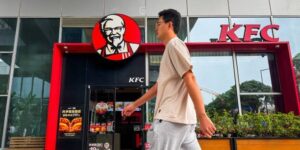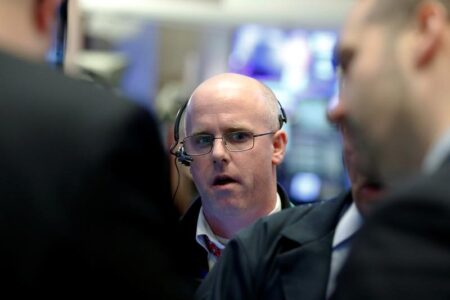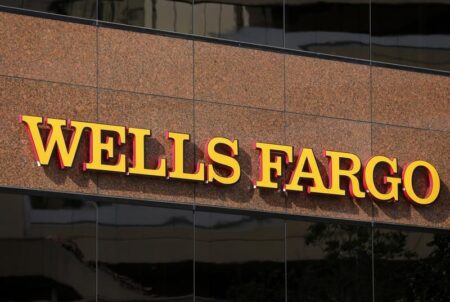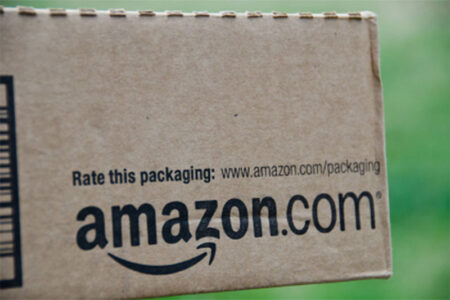European Wax Center (EWC), a leading out-of-home hair removal service provider, has announced its first-quarter fiscal 2024 earnings with a steady performance and strategic growth plans. Despite a slight decrease in same-store sales, attributed to weather disruptions and holiday closures, the company displayed strong profit margins and a solid cash position. European Wax Center is focused on expanding its customer base and increasing spending among its existing guests. With the opening of seven new centers, the company continues to strengthen its market presence and is also piloting a laser hair removal service to diversify its offerings.
Key Takeaways
- European Wax Center opened seven new centers, growing its footprint to 1,051 centers across 45 states.
- System-wide sales increased by 1.3% to $221.4 million, and total revenue rose by 4% to $51.9 million.
- The company reported a 1.2% decline in same-store sales, affected by weather and Easter-related closures.
- A new $50 million share repurchase program was announced.
- European Wax Center plans to open 75 to 80 new centers and expects system-wide sales to be between $1 billion and $1.025 billion for 2024.
- Adjusted EBITDA is projected to be between $75 million and $80 million, with adjusted net income anticipated to be $22 million to $25 million.
- The company plans to invest in a laser hair removal pilot and expects gross margin expansion.
Company Outlook
- European Wax Center aims to drive top-line growth through expanding its net new centers and in-center sales.
- The company expects to deliver consistent growth and maintain its position as a dominant player in the out-of-home waxing market.
- European Wax Center is uniquely positioned to pilot and potentially expand laser hair removal services.
Bearish Highlights
- Same-store sales saw a decrease of 1.2% due to weather-related disruptions and Easter closures.
- Advertising expenses are projected to increase by 400 basis points in the second quarter.
Bullish Highlights
- European Wax Center’s initiatives are positively impacting wax pass conversion, retail attachment, retention rates, visit frequency, and transaction value.
- The laser hair removal pilot program has been successful in attracting new guests and increasing spending from existing customers.
Misses
- The company did not provide specific quantification on the impact of weather on store closures or sales.
Q&A Highlights
- Stacie Shirley discussed the weather impact on nearly 300 store days and the shift in spending from Q1 to Q2.
- The company is back-half weighting its unit development for 2024 due to permitting delays and lease negotiations.
- European Wax Center is focused on driving Wax Pass conversion, guest retention, and retail attachment for long-term growth.
European Wax Center’s Q1 performance has set the stage for its strategic initiatives aimed at bolstering growth throughout 2024. The company remains committed to enhancing guest experiences, expanding its service offerings, and driving both new and existing customer engagement to achieve its financial objectives. With a clear focus on operational excellence and market expansion, European Wax Center is poised to maintain its leadership in the personal care industry.
InvestingPro Insights
European Wax Center (EWCZ), a prominent player in the personal care industry, has shown resilience in its Q1 2024 performance despite some challenges. The company’s strategic initiatives and expansion plans are reflected in key financial metrics and market valuation indicators. Here are some insights based on InvestingPro data and tips:
InvestingPro Data:
- The company boasts a market capitalization of $663.02 million, indicating a substantial presence in the market.
- With a Price/Earnings (P/E) ratio of 65.52 and an adjusted P/E ratio for the last twelve months as of Q4 2023 at 61.58, the company trades at a high earnings multiple.
- European Wax Center has a strong gross profit margin of 71.66%, showcasing its ability to maintain profitability in its operations.
InvestingPro Tips:
- Analysts predict that European Wax Center will be profitable this year, which aligns with the company’s optimistic outlook and growth plans.
- The company’s impressive gross profit margins are indicative of its operational efficiency and could be a key driver for future profitability.
As European Wax Center continues to expand its footprint and diversify its service offerings, these financial metrics and expert insights suggest that the company is well-positioned for growth. For investors interested in a deeper analysis, there are additional InvestingPro Tips available at Utilize the coupon code PRONEWS24 to receive an extra 10% off a yearly or biyearly Pro and Pro+ subscription, and gain access to a comprehensive suite of tools and insights for informed investment decisions.
Full transcript – European Wax Center (EWCZ) Q1 2024:
Operator: Good morning, ladies and gentlemen and thank you for standing by. Welcome to European Wax Center’s First Quarter Fiscal 2024 Earnings Call. At this time, all participants are in a listen-only mode. After the speakers’ presentation, there will be a Q&A session. [Operator Instructions]. On the call today are David Willis, Chief Executive Officer; Stacie Shirley, Chief Financial Officer; and Andrea Wasserman, Chief Commercial Officer. I would now like to turn the conference over to Bethany Johns’, Director of Investor Relations. Ma’am, you may begin.
Bethany Johns: Thank you, and welcome to European Wax Center’s first quarter fiscal 2024 earnings call. For today’s call, David will begin with a brief review of our first quarter performance and discuss our priorities for the balance of 2024. Then, Stacy will provide additional details regarding our financial performance and our fiscal 2024 outlook. Following the prepared remarks, the team will be available to take questions. Before we start, I would like to remind you of our legal disclaimer. We will make certain statements today, which are forward-looking within the meaning of the federal securities laws, including statements about the outlook of our business and other matters referenced in our earnings release issued today. These forward-looking statements involve a number of risks and uncertainties that could cause actual results to differ materially. Please refer to our SEC filings as well as our earnings release issued today for a more detailed description of the risk factors that may affect our results. Please also note that these forward-looking statements reflect our opinions only as of the date of this call, and we take no obligation to revise or publicly release the results of any revision to our forward-looking statements in light of new information or future events. Also during this call, we will discuss non-GAAP financial measures, which adjust our GAAP results to eliminate the impact of certain items. You will find additional information regarding these non-GAAP financial measures and a reconciliation of these non-GAAP to GAAP measures in our earnings release. A live broadcast of this call is also available on the Investor Relations section of our website at investors.waxcenter.com. I will now turn the call over to David Willis.
David Willis: Thank you, Bethany, and good morning, everyone. Thank you for joining us today. We began 2024 with stable frequency and spend among our current guests, signaling the resiliency and predictability of our business model. Even in an uncertain macroeconomic environment, these guests remain resilient. Net new center openings, a key growth driver for European Wax Center, were in line with our expectations as we grew center count 7.5% to 1,051 centers in 45 states. We also delivered growth of 1.3% and 4% respectively in system-wide sales and total revenue. Same-store sales were down 1.2%, and we estimate they would have been slightly positive except for weather and Easter-related center closures that impacted our top-line metrics. Profit margins were strong, and due to our asset-light, highly cash-generative franchise model, our cash position increased meaningfully during the quarter. In fact, with our growing liquidity in mind, this week our board authorized a new $50 million share repurchase program to give us flexibility as we seek opportunities to drive long-term shareholder value. On our year-end earnings call, we shared our focused initiatives to drive average ticket and frequency from both new and existing guests. We are still in the beginning stages of these initiatives, and as I will detail shortly, we are seeing good early reads. As we shared last quarter, we expected that in the current macro environment, Q1 would be the low point in our full-year results as these efforts begin to take root. We believe that these initiatives will materialize and gain traction as we move through the year. Second-quarter trends are tracking in line with this expectation. As a result, we are reiterating our fiscal 2024 financial guidance today. Before I dive into our strategic initiatives, I want to congratulate the entire European Wax Center team on being officially recognized as a great place to work for the second year in a row. Our associates are the key to EWC’s culture and success, and the leadership team and I are proud to facilitate an environment where they are free to be their authentic selves, drive performance, delight our guests, and be unleashed to do their best work. Ultimately, they are focused on consistently delivering for both our franchisees and our guests, which we fully expect will translate into continued long-term growth. Now I’d like to discuss the progress we’ve made on our two key growth vectors, expanding net new centers and driving in-center sales, as well as the plans we have for the balance of 2024. I’ll start with our unit growth vector. As planned in our development schedules, our franchisees opened seven net new centers, translating to 7.5% unit growth in Q1. Our franchisee relationships continue to strengthen as we work together to further elevate European Wax Center’s leadership position. In fact, nearly all of our expected 75 to 80 net new centers in fiscal 2024 will come from existing franchisees, showcasing their excitement for the European Wax Center business model and their commitment to reinvesting in our brand. We remain focused on the diversity of our franchisee base as well, and expect smaller independent operators, self-funded multi-unit developers, and private equity-backed franchisees to each operate approximately one-third of our centers over time. Overall, our franchisees remain well-capitalized, and our development pipeline of over 370 locations remains robust. Most importantly, these long-term commitments are a testament to the strength and resiliency of our model and give us visibility to deliver against our high single-digit unit growth algorithm for 2024, 2025, and beyond. Our key focus this year is on supporting top-line growth and strong four-wall economics for franchisees, particularly through new guest acquisition. We believe that a strong opening creates the best foundation for new centers and their unit economics. Our data-driven pre-opening playbook launched in Q1, and the centers following it are generating higher average grand opening guest lists and staffing levels. While it will take time for these improvements to move the needle on system-wide metrics, we believe they will translate into higher sales, profitability, and predictability for franchisees through their ramping cycles. Turning to our second growth vector, driving in-center sales, which benefits system-wide sales and same-store sales growth. I’ll start with the dynamics we’re seeing across our guest cohorts. As I mentioned earlier, spend and frequency among our existing guests have remained stable in 2024. This includes both our less frequent guests as well as our core guests. As a reminder, core guests are comprised of the wax pass and routine guests who drive approximately 75% of our sales volume. These guests have remained committed to their personal care routines for much of the last two years, representing a recurring and durable revenue stream for our brand through various economic cycles. We are pleased with their stability, but we remain focused on growing spend and frequency among this group. Current customers remain loyal fans of European Wax Centers’ unparalleled service, efficiency, and expertise. But attracting first-time guests remains our biggest opportunity, especially in the current macro environment where consumers appear more discerning with their spend. We have made real progress against the media, local marketing, and operational initiatives that I outlined on our last earnings call. However, it’s still too early to see the full benefits of our guest acquisition efforts. I’ll now highlight a few updates on our initiatives, starting with media. We engaged a new media agency in Q4 to streamline our strategy across all of our paid digital channels and search efforts and increase guest reservations in centers. We are pleased that this new strategy is driving reservations, new guests, and cost efficiencies. In late Q2, we expect to begin aligning our media mix to the channels and messages driving the strongest returns. As a result, we believe the biggest impact from our improved approach will come in the back half of the year. And finally, with Wax Pass holders generating more than twice the spend and frequency of non-core guests, we remain very focused on growing Wax Pass penetration. To target frequency, conversion, and loyalty, we successfully tested a 3+1 Wax Pass offer for new guests, which generated incremental sales and retention rates. As a result, we rolled it out network-wide at the end of Q1 and have already seen a positive impact. On to the second bucket, local marketing. We believe one of the best ways to drive new guest acquisition is through local marketing efforts that boost center visibility and awareness. As we ended Q1, we launched partnerships with new local digital media agencies to stimulate franchisee spending. We believe the increased effectiveness and structure under the new agencies will help us demonstrate an even higher local marketing ROI and motivate additional network investment. We also dedicated corporate personnel and introduced franchisee tools to help simplify grassroots marketing plans and execution. Enthusiasm from the network so far has been encouraging with meaningful uptake. And we expect franchisees to ramp up their local marketing spend and efforts throughout 2024. Lastly, our operational initiatives should drive new guests to the brand as well as increase spend from existing guests. First, we’ve deepened the support of our field trainers in select markets through training, coaching, and ongoing development. By optimizing the guest experience, pilot centers in this program generated improvements across our most important KPIs that impact four wall sales and profitability. We are excited about this program’s potential and are currently increasing resources to scale it as the year progresses. As I mentioned last quarter, we continue to make good progress on our proven brow tint formula. Pilot testing indicated that brow tinting attracts new guests to the brand and increases services and therefore dollars per ticket. We expect to launch this incremental service nationwide in the third quarter and support it with a robust staff training program and marketing campaign. Finally, we continue to advance our laser hair removal pilot. Early testing validated our hypothesis that expanding our service offering to laser could attract new guests to the brand and increase share of wallet from existing waxers. Our first six pilot centers in New York generated strong sales with minimal cannibalization of core waxing services. Given our confidence in these early results, we expanded the pilot to ten more New York centers during Q1 and expect to add a handful of Florida centers in Q2. These Q2 centers will help us better understand the operational impact of a stricter regulatory environment and further confirm our hypothesis that laser can enhance already robust four wall economics over time. As mentioned on our last call, we plan to make additional deliberate investments to support this pilot in other states throughout the year, including adding dedicated personnel to our corporate leadership team. While we see this as a potential additive opportunity to expand our brand and the model, European Wax Center remains the dominant player in out-of-home hair removal with a strong and resilient core service offering, waxing. As the experts in our category, we remain uniquely positioned to leverage our scale and footprint to pilot laser and look forward to updating you on our progress. Ultimately, we are confident in our ability to drive new guests to the brand and increase ticket value and frequency among existing guests through the initiatives I outlined. We believe that our data-driven strategies will allow us to deliver another year of top-line growth in 2024. With that, I’d like to hand the call over to Stacie Shirley to review our financial performance and guidance. Stacie?
Stacie Shirley: Thanks, David, and good morning. Before I begin my remarks, I’d like to remind everyone that in some instances I will speak to adjusted metrics on this call. You can find reconciliation tables to the most comparable GAAP figures in our press release and 10-Q filed with the SEC today. As a reminder, both fiscal years 2022 and 2023 included a 53rd week. The fiscal 2024 returns to a 52-week year. Turning now to our first quarter financial performance, we added seven net new centers during the quarter in line with our expectations. System-wide sales grew 1.3% to $221.4 million as a result of our ramping centers, and total revenue, which includes wax and retail products we sell to the network, increased 4% to $51.9 million. Same-store sales were down 1.2%. Excluding the impact of center closures related to inclement weather in January and a shift in Easter timing between quarters, we estimate Q1 same-store sales would have been slightly positive. As a reminder, same-store sales reflect in-center transactions and wax pass visits as they are redeemed, while system-wide sales is predominantly a cash-based metric that we recognize as payments for products, services, and wax passes are received. In terms of profitability, first quarter gross margin improved approximately 290 basis points to 73.9%, primarily a result of negotiated cost savings. Q1 SG&A decreased 22% year-over-year to $13.5 million, and as a percent of revenue, improved 860 basis points to 26%, compared to 34.6% in the prior year. This decrease was driven by the modification of certain pre-IPO equity awards that added an incremental $3.9 million in share-based compensation to Q1 last year. First quarter SG&A this year was also positively impacted by the timing of technology, professional, and laser-related expenses that we expect to shift into Q2. Q1 adjusted EBITDA dollars increased 7.4% year-over-year to $17.5 million, and margin improved 100 basis points to 33.7%, driven by the flow-through of the cost savings I just mentioned. With higher interest income in 2024, net interest expense decreased to $6.3 million from $6.9 million in the same period last year. Income tax expense was $1.2 million, compared to a benefit of $500,000 last year. Despite the increase in taxes, GAAP net income improved to $3.7 million, and adjusted net income grew 41.3% to $4.8 million. Turning to the balance sheet, we ended the first quarter with $60.4 million in cash, and net cash provided by operating activities was $10.7 million, compared to approximately $100,000 in investing outflows. As David mentioned, strong free cash flow is a staple of our asset-light capital-light model. We had $393 million outstanding under our senior secured notes, and our $40 million revolver remains fully undrawn. Net leverage at the end of Q1 was 4.2 times adjusted EBITDA, and our guidance implies net leverage to be at or below four times at the end of this year. Our leverage expectations do not reflect any share repurchases we may execute under the new $50 million authorization approved by our board this week. As a reminder, we fulfilled our previous $40 million repurchase authorization in Q4 2023, and believe that an additional authorization gives us flexibility to be opportunistic as we drive long-term shareholder value. We remain committed to delivering organically over time through adjusted EBITDA, growth, and continuously evaluating the best use of our strong free cash flow. Turning now to our outlook for 2024. Given stable trends for existing guests and the expected progression of our initiatives to drive greater share of wallet and new guest acquisition, we are reiterating our full-year guidance. Our outlook assumes a stable macro environment, and that our focus initiatives will materialize as we progress through the year. While data points thus far have been encouraging, we are still in the early stages of these specific initiatives, and we continue to monitor how they are resonating with new and existing guests in this macro environment. In terms of unit growth, we continue to expect franchisees to open 75 to 80 net new centers in 2024, driven primarily by existing franchisees and focused on markets where we have had less development activity in recent years. Based on franchisee construction schedules, we are updating the expected timing of those openings to approximately one-fourth in the first half of the year and three-fourths in the second half. On the top line, we continue to expect system-wide sales between $1 billion and $1.025 billion, or approximately 6.5% to 9% growth on a 52-week adjusted basis, as well as 2% to 5% same-store sales growth for the year. As David noted in his remarks, we believe our top line will benefit more from our focused strategic initiatives in the second half of the year than in the first half. With the rollout of these initiatives in mind, we expect system-wide sales dollars to be the lightest in Q1 and spread fairly evenly between the second and third quarters. We still anticipate that Q1 same-store sales will be the lowest this year, with subsequent quarters following a consistent ramp as our top line initiatives take root. As David mentioned, second quarter to date is tracking in line with this expectation. We continue to expect total revenue between $225 million and $232 million. On a full-year basis, revenue as a percent of system-wide sales will be impacted by the 2024 removal at a COVID-related surcharge for franchisees. However, even without the surcharge in place, we expect underlying cost savings to drive gross margin expansion in fiscal 2024. From an expense standpoint, on a full-year basis, we expect advertising as a percent of revenue to be flat to last year. However, we currently plan for advertising expense to be approximately 400 basis points higher year-over-year in Q2 to align our spin with the ramp of seasonal traffic and to drive initiatives we’ve described. As shared on our last call, we expect to invest approximately $4 million of operating expenses, a significant portion of which is foundational and one-time in nature, to support the expansion of our laser hair removal pilot. We plan to incur these expenses at a greater pace in Q2 and further increase them over the balance of the year. We’ve seen encouraging results in the early stages of this pilot, but above all, we remain focused on our strong, resilient, and profitable core service offering, waxing. Including these incremental laser costs, our adjusted EBITDA outlook remains approximately $75 million to $80 million. Absent the laser investment, we would expect to drive adjusted EBITDA margin expansion in 2024. We expect approximately $28 million of interest expense this year and currently believe our 2024 effective tax rate will be approximately 25% before discrete items. Given our capital structure, we expect our blended statutory tax rate will be approximately 20% and expected to increase over time as pre-IPO shareholders exchange to Class B shares for Class A shares. As a result, we expect adjusted net income between $22 million and $25 million. In summary, we remain confident in our resilient, asset-light model, recurring predictable visits from our core guests, and our well-capitalized franchisee base. We are pleased with the progress we continue to make on our strategies to drive in-center sales growth in 2024. We believe we are making investments in the right areas to extend our position and continue taking shares as the undisputed leader in the highly fragmented out-of-home care removal category. We’d now like to open up the call for questions. Operator?
Operator: Thank you. [Operator Instructions] The first question comes from Randy Konik with Jefferies. Your line is now open.
Randal Konik: Hey, good morning, everybody. I guess, David, first I just need a clarification. When you look at the first quarter same-store sales and you talked about the weather headwind, the Easter shift, and you talked about slightly positive, what would have been the result? Does that mean a 0.1 or a 1% type comp? Just that? And then when you talk about in the guidance, I think the second and third quarter are supposed to be equal in terms of your same-store sales assumption. Are you tracking in the range of that annual guidance of 2 to 5 right now? Is that kind of what we should take away?
Stacie Shirley: Good morning, Randy. This is Stacie. So a couple of things. We weren’t more descriptive or prescriptive as it relates to that slightly positive. As you know, these are estimates, and so that’s kind of where we came out when you take the combination of both of those impacts. As it relates to the guidance we gave on Q2 and Q3, it wasn’t same-store sales. That was system-wide sales. So we would expect both Q2 and Q3 to be more similar. In the past, Q2 is usually the heaviest quarter, but as a result of the ramp of the initiatives, we would expect both of those quarters to be a little more in line than what they’ve been in the past.
Randal Konik: Got you. Okay. And then just as we think about over the, let’s say, the medium term, a couple things. As we think about the ability to drive venue growth, how do you think about the different levers of price versus frequency of guests versus service per visit growth? Just give us your perspective there. And I’d love to understand, in the laser test that you’ve done so far, are you getting a different type of guest? Are they trying to loop in some waxing services when they do laser? I’m just curious on what type of behaviors they’re exhibiting in the laser test units versus the non-laser units that are out there. Thanks.
David Willis: Yes, Randy, thanks for the question. As it relates to driving revenue growth, the mix between price and frequency and dollars per ticket, generally we expect to drive more tickets and dollars per ticket. Let me double-click on that. So when we talk about our field trainer support program, this is where we deploy field trainers into different markets. And we’re seeing an immediate impact on our ability to influence wax pass conversion, retail attachment. So for the guests that are coming into those centers, we’re able to drive better retention rates, visit frequency, and dollars per transaction. What we’ve really modeled is on the backside of what we internally refer to as Operation Elevate is to bring in our marketing team to really drive local grassroots marketing on the backside of Operation Elevate. That’s intended to drive more momentum and ultimately drive more guests. So it is a combination approach, Randy, but we’re confident in our ability to move the needle without just having to rely on taking price. As it relates to laser, it is our hypothesis in this initial pilot program was that we could attract more new guests to the brand and drive greater share of wallet from our existing wax guests. The six-center pilot was expanded to 10 centers because we saw enough data to confirm that. The third data point is we wanted to ensure that cannibalization of our core waxing services were contained within acceptable levels, and we’re also seeing that. The ultimate bellwether for laser for this brand is, is it accretive on both top line and bottom line? And while we’re incredibly encouraged with the initial results, we want to get smarter in some other states where the regulatory environment is a bit stricter than in New York. So that’s what’s leading us to expand the laser pilot to Florida. We’re taking it to our corporate-owned centers in Florida, and we’ll continue to monitor. We have strong interest from our network to further expand into other states, so we will continue to evaluate laser potential within the brand. Hope that helps, Randy.
Randal Konik: Yes, it helps. Thank you so much.
David Willis: Of course.
Operator: One moment for the next question. Next question will come from Scot Ciccarelli with Truist. Your line is open.
Scot Ciccarelli: Good morning, guys. Thanks for the time. It looks like for comps to hit the low end of your annual guide, you need positive low single digits and 2Q, kind of ramping that to mid-single digits for the balance of the year. And then by our math, to hit the high end, you basically need a steeper slope with an exit rate of really high single digits, almost even double digits. So I guess the questions are, can we assume that you are posting positive low single digits today? And second, is that fair assumptions regarding kind of the slopes of the curve you guys are thinking about for the balance of the year?
Stacie Shirley: Good morning, Scott. I think that what you said is pretty reasonable, right? What we’ve said is that it will be a steady and consistent growth as we progress through the year as a result of these initiatives that we have in place that we’ll continue to monitor. So I think your basis of your calc [ph] is pretty reasonable. It’s definitely more back-end loaded as it relates to, most importantly, these initiatives and continuing to resonate this new guest. And then for Q2, what we’ve said is we’re in line or in tracking with the expectations that we’ve put forward as the 2% to 5%.
David Willis: But Stacie, just to be clear, the current plans in place in terms of the change of marketing, etcetera, the expectation is that can get you to mid-single digit to high single digit kind of exit rate by the end of the year, fourth quarter.
Stacie Shirley: Yes, I mean, as you do your math, right, is a negative 1.2, and then you have to see how you would have to ramp to get to that 2.5. Again, that’s, I think, a reasonable assumption is how you would get there.
David Willis: Yes, Scott, let me just add on to that. So our reiterating the guide assumes a stable macro and that the initiatives we’ve been discussing will, in fact, drive the results and impact as we progress through the year. There’s a couple of proof points that we are seeing that is informing this reiteration of the guide. One is the National Media Agency retained in Q4, they laid the groundwork, and we’re seeing this drive reservations, new guests, and cost efficiencies. And they’re working on optimizations of that strategy that we expect to drive further impact as we move through the year. I just touched on Randy’s question, our field trainer support program. We’re incredibly excited about this. We had the pilot we launched in Q4. We expanded to a few additional centers late Q1. Really important takeaway for us is the improvements we’re seeing in four well KPIs are actually, the franchisees are able to sustain those after our field trainers have done their work and leave these markets. So our goal with this program and intention is to further scale this program as we move through the year. Fairly smaller data set, but we had talked on previous calls about our NCO playbook. This is a data driven playbook that’s very prescriptive about the spend required before a center opens, staffing required, the training of the staff, and for this was launched late Q1 and those centers that opened following the new playbook, we’re seeing them open with more new guests in their file day one, properly trained staff, and as we would have expected, a faster ramp in both tickets and revenue for these new centers. And then finally, one last data point, Scott, is our local digital agencies. We brought on April 1. We’ve had just over 400 of our centers sign up and start leveraging these new agencies. And we’re seeing early leads that are very encouraging. So I wanted to give at least a few examples of these early proof points. Those combined with our second quarter date trends are what give us confidence in reaffirming kind of the full year outlook.
Scot Ciccarelli: Got it. Super helpful, guys. Appreciate it.
David Willis: Sure.
Operator: Our next question comes from Dana Telsey with Telsey Advisory Group. Your line is open.
Dana Telsey: Hi. Can you just review regionally, did you see anything different by region in terms of what you saw in California, for example? How is that performance versus the rest? And then in terms of pricing and labor costs, anything changing in terms of pricing and labor costs in terms of you taking price going forward? And is there anything we should be mindful of with the new marketing agency that impacts second quarter, third quarter, and fourth quarter that could be meaningful? Thank you.
Stacie Shirley: So from a geography standpoint, Dana, and sorry, good morning, nothing really to call out. There was weather throughout the, in different places hit a little bit harder. So that’s probably the only thing that I would say. But from a California perspective, not so much top line. We continue to have the challenges, from the increasing cost of labor and construction. But that’s those are things that we’ve just continued to deal with.
David Willis: Yes, Dana, I would just add, as it relates to labor costs, no major headlines in terms of across the network. There’s obviously isolated markets that have seen elevated minimum wage rates go into effect earlier this year. And in select markets, we’ve seen franchisees take price in those markets to accommodate the elevated labor costs. Maybe, Andrea, you want to touch on how we’re thinking about pricing overall.
Andrea Wasserman: Sure. Hi, Dana. So as a reminder for everybody, we did recommend price increases in 2021. And again, in 2022. But as you know, our franchisees set their own prices, and some have taken prices up over the past year as well. Based on the always on analysis and monitoring and evaluating of the situation that we continue to do, we don’t plan to recommend a system wide price increase this year. But we continue to put science behind that. We would consider different pricing scenarios market by market. We’re looking across our own costs, our four wall margins for our franchisees, the pricing elasticity that we see consumers to exhibit, the transactions trends that we experience and what the competition is doing. So all of that is factoring into the way that we are continuing to look at the landscape.
Dana Telsey: Got it. Thank you.
Operator: One moment for the next question. The next question comes from Lorraine Hutchinson with Bank of America. Your line is open.
Lorraine Hutchinson: Thank you. Good morning. I was curious what the feedback was from franchisees around the NCO program and has that alleviated any concerns they may have on the profitability ramp of future centers given the higher cost to open?
David Willis: Well, I tell you, Lorraine, good morning. Those franchisees that launched with the new NCO playbook, I would say, are fully endorsing it. They’re seeing good early results. Very small data set as we turn this on kind of midway through Q1. But we also put in place, Lorraine, two things. There’s two concerns that franchisees had that we wanted to address. One is the ramp and profitability of an NCO. And I think this data, this playbook, helps address that and gives them the best chance to ramp with more momentum, get to faster break even, and ultimately, a faster ramp to the very attractive 50% cash on cash returns. The other thing that we’re doing, we are sensitive to franchisees’ concern that we oversaturate or overdevelop a market. So we aligned with our Franchise Advisory Council to come up with mutually agreed upon market impact guidelines. So our real estate models already factored in and modeled if we were going to develop a particular location, what impact that would have on surrounding centers. We’ve always worked under the assumption and parameters that a 5% to 10% cannibalization would be acceptable for multi-unit growth concept. So we’ve aligned with our Franchise Advisory Council to say if a given site that’s selected by a franchisee is expected to have an outsized impact on the surrounding centers, we’ll look for another location. So we’re really trying to address this both ways, giving those NCOs the best opportunity to drive profitable growth while protecting the profitability of surrounding franchise locations.
Lorraine Hutchinson: Thank you.
Operator: One moment for the next question. The next question comes from Korinne Wolfmeyer with Piper Sandler. Your line is open.
Korinne Wolfmeyer: Hey, good morning, team. Thanks for taking the questions. My first one is, I’m just wondering if there’s any way you could better quantify the Easter and weather impact and maybe you could give us some color on, how many centers were actually closed on the Easter holiday. And then how many centers and how many days were closed due to weather? And maybe that could help give us a little bit more comfort that there’s not some other impact going on like the macro or weaker episodic gas trends that may also be contributing to that lower same store sales. Thanks.
Stacie Shirley: Good morning and appreciate the question, Korinne, but we’ve not broken it out between those two pieces. What I can tell you from a weather perspective, nearly 300 store days is kind of what we calculated in January across those kind of 12 different states. And so it was very impactful for sure, but we’ve not quantified it any further than that. And then, of course, on Easter, we’re closed that day.
Korinne Wolfmeyer: Got it. Thanks so much. That’s helpful. And then I think in the prepared remarks, you talked a little bit about a spending shift from Q1 to Q2. Is there a way you can quantify that and then maybe help give us a little bit more color on how we should be thinking about the margin cadence for the remainder of the year? Thank you.
Stacie Shirley: Sure. So from a from a gross margin perspective, I’ll start there. We had — saw a very significant increase in Q1 as a result of these kind of negotiated cost savings that we’ve had. I would expect to continue to see an improvement over the balance of the year, not to the size of what we saw in Q1. It was definitely outsized. Certainly, as we get to the back half, we’re going to start anniversary. Some of those cost savings that we started to see at the end of 2023 from the other, I guess, guidance that we provided, we didn’t quantify the impact of the shift in timing of professional fees and technology. The biggest thing to take into account in Q2 is what we said about advertising that we would expect about a 400 basis point increase as a percentage of revenue for the quarter as we are, again, ramping up these initiatives to support that and then also getting more in line with just the seasonal traffic.
Korinne Wolfmeyer: Great. Thank you.
Stacie Shirley: You’re welcome.
Operator: One moment for the next question. The next question comes from Simeon Gutman with Morgan Stanley. Your line is open.
Simeon Gutman: Good morning. I want to ask about a new center productivity. I think it’s hard for us to get the correct math. And then following up, getting to the looks like you need to do three comps the rest of the year to get to the guidance range, at least the low end. You had about 100 stores coming into this year. You’ll have another 100 through this year. So the ability to get to that comp range with nearly 20% more units as well and how that may interact with the trajectory of the year.
David Willis: Yes, I mean, so on the new center productivity, as I mentioned earlier, it’s a very small data set. At least those centers that open with our NCO playbook requirements. But we’re very pleased. I mean, their ticket trajectory, their revenue trajectory, a few weeks to a few months in some cases with some of these centers is, looks like centers pre-COVID in terms of what is the productivity of these new centers. Now, having said that, our guides, I mean, I think you’d mentioned 100 centers this year. Our guide for unit development is 75.
Stacie Shirley: 100 coming in.
David Willis: Oh, I got you. 75 to 80 for the full year. But we do expect to hit within our guidance. We fully acknowledge this is a quarter over quarter over quarter improvement in our comp. And the initiatives that we’ve talked about in the early data points are giving us that confidence that these will materialize and drive greater impact as we progress quarter to quarter to quarter.
Simeon Gutman: Thanks for that. On expenses, I think Stacie said I was going to ask how much expenses shift from Q1 to Q2. I don’t think you’re quantifying. And then the IPO awards, just refresh what that was from. And then is this new run rate going forward or do we see some of that expense come back at any point?
Stacie Shirley: So in Q1 last year, there was almost $4 million of kind of, let’s say, a one time or not one time, but an outsized amount related to the pre-IPO grants. So that you can completely take that out as it relates to the ongoing run rate. And so what you would see quarter-over-quarter is pretty consistent. It’s, I think we’d call it out as roughly, $2 million, something like that.
Simeon Gutman: Got it. Okay. Thanks, everyone. Good luck.
David Willis: Thanks Simeon.
Operator: One moment for the next question. The next question comes from Jonathan Komp with Baird. Your line is now open.
Jonathan Komp: Yes. Hi. Good morning. If I could just follow up on the plan for unit development here in 2024, I think, three quarters back half weighted is more weighted to the back half than we’ve typically seen. Could you maybe just comment on any individual circumstances leading to the shape of the year and really visibility to that second half ramp?
David Willis: Yes, Jon, good question. Thank you. It is it is more back half weighted than what we saw last year. There were six centers that we had scheduled to open in Q2 that are going to move to the back half of the year. Three of those in the Northeast just had some permitting delays. Three of those lease negotiations with landlords took an extended period of time. We have every confidence all six of those centers will open in 2024. So while we are back half loaded, I don’t have any concerns that that this is going to push further as of today Jon. Our franchisees remain committed, developing with the brand. They continue to make solid cash on cash returns. So hopefully that addresses your specific question.
Jonathan Komp: Yes, that’s really helpful. Maybe just one other broader question. If you think about, really the right same-store sales run rate for this business over time. So not directly tied to 2024. But over time, how are you thinking about same-store sales? I know at one point, the view was towards high single digit comps. I don’t know if you have any updated thoughts relative to that. Thanks again.
Stacie Shirley: Yes, appreciate the question. Clearly that is where our long term algorithm is. That’s what we have spoken about. And to get there, it’s a low single digit for mature centers and high single digit for ramping. And we believe that we still have the opportunity to get back there. And as we progress through the year, we’ll get closer, especially on the mature centers, getting back to that long-term ramp, assuming that, again, the things that David talked about before, a stable environment, as well as these initiatives really starting to materialize. So we still believe that that is something that we can achieve in this model.
Jonathan Komp: Okay, thanks. Thanks again.
Stacie Shirley: Thank you.
Operator: One moment for the next question. The next question comes from John Heinbockel with Guggenheim Partners. Your line is open.
John Heinbockel: Hey, David, can you expand on the field training initiative, right, in terms of what they’re specifically working on? I don’t know if they’re training Wax specialists, managers, etcetera. You talked about KPIs, right? So what are the KPIs that you think are most critical? And then lastly, I’m just curious, right, obviously, you’re going to have multiple trainers, doing a lot of stores. I’m just curious, ultimately, is this a 50 person effort? Is it 100 person? What’s the size of it, if you think about it?
David Willis: Yes, John, thanks for the question. So, today we have we have less than 10 field trainers. So I want to give this some level of context. While we would like to expand this team, we’re not signaling a fundamental change in our OpEx structure. I think the impact these folks can drive and center flows through very nicely, both to our revenue and ultimately to our EBITDA line. When I look at a given market, so John, the way we’re approaching this is go to a given market and that market may be, it’s a larger franchisee group. Maybe it’s one franchisee. If it’s a market that has a collection of smaller groups, the combination of our field business consultant and field trainers really deploying to that market, and they live in that market for weeks at a time. So instead of just checking on the centers or doing a quarterly business review, they embed themselves in the markets to evaluate are the centers properly staffed? Are they following the playbooks? And really hands on coaching, mentoring, guiding the very playbooks that we put out to the network. The KPIs that we’re focused on and that we’re moving the needle on are Wax Pass conversion, guest retention. So we measure guest retention. Is that guest visited your center? Did they either rebook or rebook to visit that center within the next 60 days? And driving retail attachment. So it’s a different approach than just kind of a couple of times a year, four times a year touch base with the franchisee on here’s your opportunities to drive improvement in your centers. It’s very much a hands on approach. And we’re very pleased with kind of the early reads thus far. We’ve been we had the one pilot center in Q4 of last year. We went to another market late Q1 of this year. And so our goal and plan is to further scale this program as we progress through the year.
John Heinbockel: All right. Maybe as a follow to that. Right. If we take you think about the ramp and system wide sales right from where we are now to let’s say the fourth quarter and you put it into four buckets. Right. You got core and non-core. And then you got right traffic and spend. Where do you think the biggest ramp is the most significant ramp is going to come in those buckets?
David Willis: John, can you clarify core and non-core?
John Heinbockel: Right. Well, I think you said right. Core is I want to make it simple as opposed to Wax pass and casual. So I think about core is 75% non-core. I think 25, right. So if I think about that, 75 and the 25. And then I think about right traffic and spend in each of those. So those four buckets. If you said this one or one or two are going to drive disproportionate ramp, what would that be?
David Willis: I don’t know that there’s one that’s going to drive a disproportionate ramp. If I think of our existing guests, so both core and non-core, I see a decent part of this ramp through the year coming from the existing guest file. So of our core guests, we wanted to get a greater share of wallet. So our probably best opportunity there. They’re already coming on a regular cadence is probably drive better retail attachment or an add-on service. The opportunity for our non-core guests that are coming less frequency is can we get them on a wax pass to get them on that regular routine. So if I look at kind of as we expect the ramp, I think the lion’s share of that is going to come from the existing guest file, getting more visits and more dollars per ticket. And I think we talked briefly on this in our prepared remarks. I think we have a huge opportunity in terms of attracting more new guests to the brand. In this environment, we get that consumers that are not already on a waxing routine might be a little more challenging to convince them to start waxing. But we’re very pleased with the early reads from our national media program and we’re encouraged with the very early reads of our local digital agency program. So hopefully that gives you a little more color, John, how we’re thinking about it.
John Heinbockel: Thank you.
Operator: [Operator Instructions] The next question comes from Kelly Crago with Citi. Your line is now open.
Kelly Crago: Hi, everyone. Thanks for taking our question. I just wanted to focus in on the comp performance in 1Q. So x, the timing shifts and closures, the slightly positive comp. It was below how consensus is modeling. So I’m just curious how the comp performance was relative to your plan going into the quarter. You mentioned and we talked a lot about the weakness that you saw from new guests. Was that what you expected given you did have this partnership with this new media agency. And then just secondly, any color on more color on that episodic guest performance versus expectations given there are some there are more susceptible to fluctuations in the macro.
Stacie Shirley: Great. Thanks, Kelly. As far as the comp in Q1. So we don’t really provide one. As you know, we don’t provide specific quarterly guidance or kind of what our internal expectations are. However, we did say on our call in March we expected Q1 to be the low point of the year due to the rollout of these initiatives and those taking starting to materialize. And of course, at that point, we were aware of weather and the impact of Easter. And so we still maintain that expectation that Q1 is going to be the low point for the year. And we reiterated, the guide for 2% to 5% for the full year. So that’s kind of where we’re sitting today.
David Willis: Kelly, I would just add in terms of the episodic guests in Q1. We actually saw that part of the file remain stable in terms of her visit frequency and her spend Our biggest opportunity is as we talked earlier is really attracting more new guests to the brand and we expect more new guests added to our file as we progress through the year. Again, part related to our national media agency, but we expect more momentum to come from the local digital agencies in these local grassroots efforts. We’re seeing already that the franchisees embracing this grassroots marketing playbook are making a difference in their centers.
Kelly Crago: And just one more for me on the cadence of the comps, extra shift. Did you in the closures. Can you just give in color on maybe how the comp performance progressed through the quarter to kind of better understand the run rate exiting 1Q.
Stacie Shirley: We don’t provide the monthly performance metrics, however, obviously January was where we were significantly impacted, as I mentioned before, estimated about a 300 store days of closures and then of course in March, it was the shift, but we haven’t quantified it further than that. Other than say in Q2, we are tracking to where we think we, the expectations that we have for the year.
Kelly Crago: Thank you.
Operator: I show no further questions in the queue at this time. I would now like to turn the call back to David Willis for closing remarks.
David Willis: Thanks, Michelle. And thank you everyone for your time on the call today. We look forward to speaking with you in the days and weeks to come and to delivering on our long-term growth objectives. Thanks for attending the call.
Operator: This does conclude today’s conference call. Thank you for participating. You may now disconnect.
This article was generated with the support of AI and reviewed by an editor. For more information see our T&C.
Read the full article here
















